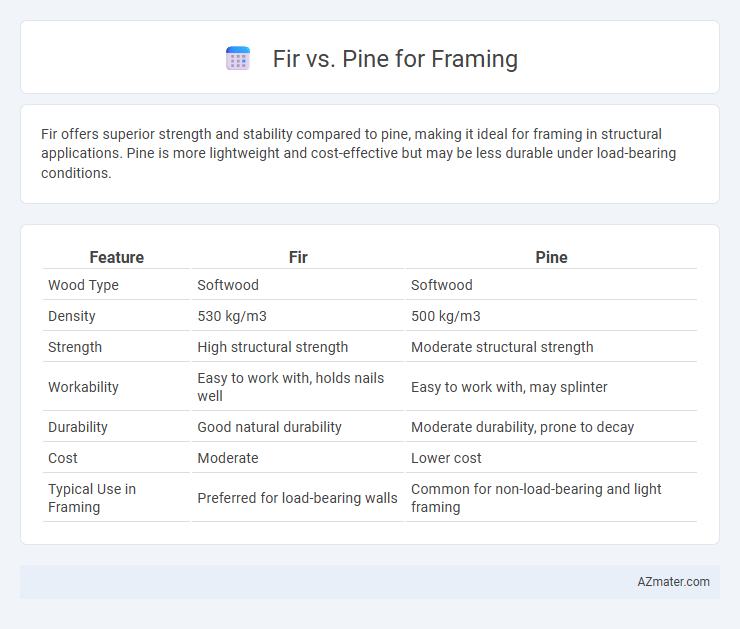Fir offers superior strength and stability compared to pine, making it ideal for framing in structural applications. Pine is more lightweight and cost-effective but may be less durable under load-bearing conditions.
Table of Comparison
| Feature | Fir | Pine |
|---|---|---|
| Wood Type | Softwood | Softwood |
| Density | 530 kg/m3 | 500 kg/m3 |
| Strength | High structural strength | Moderate structural strength |
| Workability | Easy to work with, holds nails well | Easy to work with, may splinter |
| Durability | Good natural durability | Moderate durability, prone to decay |
| Cost | Moderate | Lower cost |
| Typical Use in Framing | Preferred for load-bearing walls | Common for non-load-bearing and light framing |
Introduction to Fir and Pine for Framing
Fir and pine are popular softwoods used for framing in construction due to their strength and workability. Douglas fir, known for its high strength-to-weight ratio and stiffness, offers excellent structural integrity and resistance to warping, making it ideal for heavy framing components. Pine, including species like Eastern white pine and Southern yellow pine, provides good dimensional stability and is valued for its ease of handling and fast growth, resulting in cost-effective framing material.
Wood Strength: Fir vs Pine Comparison
Douglas fir exhibits superior wood strength compared to most pine species, making it a preferred choice for structural framing in construction. Its higher density and stiffness contribute to greater load-bearing capacity and resistance to bending, often exceeding the performance of southern yellow pine and white pine variants. Builders favor fir for critical framing components where durability and strength are paramount, ensuring long-lasting structural integrity.
Durability and Longevity of Fir and Pine
Douglas Fir offers superior durability and longevity for framing due to its dense grain and natural resistance to decay and insect damage, making it ideal for structural applications. Pine, while generally more affordable, tends to be less durable and more susceptible to moisture and pests, which can reduce its lifespan in framing projects. Choosing Douglas Fir ensures a longer-lasting framework, especially in environments prone to humidity or termite exposure.
Workability and Ease of Handling
Fir wood offers superior workability for framing due to its straight grain and uniform texture, making it easier to cut, nail, and shape with minimal splitting. Pine is also workable, but its softer nature can lead to dents and requires more careful handling to avoid damage during installation. Both woods are widely used in construction, but fir's consistent density enhances ease of handling and structural reliability in framing applications.
Cost Differences: Fir vs Pine
Fir typically costs more than pine due to its denser grain and higher structural strength, which enhances durability in framing applications. Pine is generally more affordable and widely available, making it a cost-effective choice for budget-conscious construction projects. The price difference influences material selection based on the balance between upfront costs and long-term performance in building frames.
Environmental Impact and Sustainability
Fir wood, particularly Douglas fir, is renowned for its strength and fast growth rate, making it a sustainable choice for framing with a lower environmental impact due to its carbon sequestration efficiency. Pine, often sourced from sustainably managed plantations, offers a renewable resource with a slightly lighter carbon footprint during harvesting and processing. Both fir and pine contribute positively to sustainable construction when harvested responsibly under certified forestry programs like FSC or PEFC.
Availability and Sourcing of Fir and Pine
Fir and pine are widely available softwoods commonly used in framing, with fir typically sourced from the western regions of North America, often found in abundance in Pacific Northwest forests. Pine is more broadly distributed across North America and Europe, making it easier to source locally in many regions, which often reduces transportation costs and environmental impact. The consistent availability of fir from sustainably managed forests contrasts with the more variable supply of pine, which depends on species and regional forestry practices.
Resistance to Pests and Decay
Fir wood exhibits moderate resistance to pests and decay, making it suitable for framing in areas with lower insect activity and moisture exposure. Pine, particularly pressure-treated varieties, offers enhanced resistance to termites and fungal decay, providing superior durability in harsher environments. Choosing pine for framing projects ensures better longevity and structural integrity compared to standard fir in pest-prone or damp conditions.
Common Applications in Framing
Fir wood is favored for framing due to its strength, stability, and resistance to warping, making it ideal for load-bearing structures and wall studs. Pine is commonly used for non-structural framing elements such as fascia boards and interior trim because of its availability and ease of handling. Both species are widely used in residential construction, but fir's superior durability makes it the preferred choice for critical framing components.
Which is Better? Choosing Between Fir and Pine
Douglas fir offers superior strength and stability compared to pine, making it the preferred choice for structural framing in construction due to its ability to support heavier loads and resist warping. Pine, while more affordable and easier to work with, generally lacks the durability and load-bearing capacity required for critical framing applications. For projects demanding long-term structural integrity, fir is better suited, whereas pine may be suitable for lighter framing needs or temporary structures.

Infographic: Fir vs Pine for Framing
 azmater.com
azmater.com